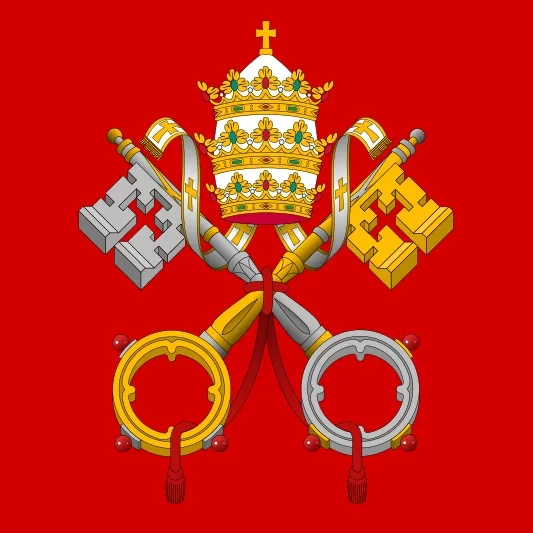The former St. Andrew’s Catholic Church in Roanoke, Virginia, is now the Basilica of St. Andrew. / Credit: Risen Aerials
Washington D.C., Oct 14, 2023 / 10:04 am (CNA).
A church in southwestern Virginia known for its architecture, art, and prominent place atop a hill is the latest in the United States to be named a minor basilica.
The former St. Andrew’s Catholic Church in Roanoke, Virginia, is now the Basilica of St. Andrew.
The Diocese of Richmond announced the designation Thursday, several days after being informed by the Vatican’s Dicastery for Divine Worship and the Discipline of the Sacraments.
Some priests of the diocese have long thought it should have that title, said Father Kevin Segerblom, who in a telephone interview Friday called the basilica “living art.”
“Ours is not huge — it seats 500 — but ours is particularly beautiful. So people come in and their minds and their hearts are lifted up to the divine,” said Segerblom, who leads St. Andrew’s and whose title has now changed from pastor to rector. “It’s important that those special churches be recognized as places of pilgrimage so that people will come here and have that experience.”
During the year-and-a-half-long application process, Segerblom asked churchgoers to say a printed prayer to “Glorious St. Andrew” asking for his intercession with God that the church be named a basilica.
“May the beauty of this building, the reverence of the liturgies we celebrate here, and the pastoral work we engage in with charity draw many more people, as you did, to faith in Jesus Christ and the fullness of life in the Spirit,” the prayer says.
Interior photo of Basilica of St. Andrew in Roanoke, Virginia. Credit: Ryan Hunt/Catholic Diocese of Richmond
St. Andrew’s Parish was established in 1882. The current yellow-brick, twin-steeple, high Victorian Gothic church was dedicated in 1902. It recently underwent a renovation of its interior and exterior.
Longtime churchgoers told CNA they are thrilled with the announcement.
“I think the beauty of the church lent itself to be a basilica. It’s quite a facility, and I’ve always been proud of it, said Mick DeSimone, 67, a retired painter who joined the parish in 1980 and currently serves the altar for expositions of the Eucharist and coordinates several Masses a week. “It’s one of the first things people see when they come into Roanoke, and I think it’s fitting that it’s happened.”
While the appearance of the building attracts newcomers, the people of the parish keep them coming back, another parishioner told CNA.
“When you come here, when you walk in, you’re just awed by the beauty of the church. I think that’s something that would draw a person to come. But the parish and the people are so welcoming,” said Donna DeSimone, 67, a retired second grade teacher, Mick’s wife, and a former Baptist who joined the Catholic Church in June 2022 through the parish’s Rite of Christian Initiation of Adults program. She is now secretary of the parish council.
Catholics not plentiful
The state of Virginia is only about 8% Catholic, according to a 2021 University of Virginia study — and less so in the mostly rural southwestern part of the state.
That makes the basilica designation particularly meaningful for Catholics who attend St. Andrew’s.
“It just confirms the fact that Catholicism is alive and well in southwest Virginia. And that church has stood there for more than a hundred years as a symbol of that,” said Susan Thompson, 74, who taught for 32 years at next-door Roanoke Catholic School, most of that time running the school’s prekindergarten through grade seven program.
The church building has a magnetic quality that draws strangers in and changes them for at least a short while, one parishioner said.
“When you come out of Mass many times you’ll just see people standing in the parking lot looking at it. They know it’s a church but they don’t know what denomination. They’re just curious. And then when they come in, it takes their breath away,” said Grimes Creasy, 62, a civil-law attorney and member of the parish council. “And then they get very reverent. That’s the interesting thing. You can see their body posture change. They recognize they’re in a holy place. They just kind of straighten up.”
Bishop Barry Knestout, who heads the Diocese of Richmond, plans to read the Vatican’s official announcement and bless physical symbols signifying the church’s elevation to basilica during a Mass at St. Andrew’s on Sunday, Dec. 3.
“With this decree, I hope more individuals will be drawn to visit this special treasure, and in doing so, will draw more to inquire about our faith,” the bishop said in a written statement Thursday.
He tied the basilica announcement to the U.S. bishops’ current three-year National Eucharistic Revival.
“May this basilica continue to be a place of personal encounter with Christ, a place of robust faith formation, and through its beauty — externally and in the liturgy — elevate the hearts and minds of all who attend Mass here,” Knestout said.
The rector of the new basilica, Father Kevin Segerblom, at the lectern. Credit: Ryan Hunt/Catholic Diocese of Richmond
What is a basilica?
A basilica in the Catholic Church is a church building singled out for honor by the pope for its beauty and renown. Most are large.
A basilica doesn’t need to be a cathedral — a word that comes from the Latin “cathedra,” or chair, which symbolizes the authority of the bishop. Most basilicas aren’t cathedrals. And most cathedrals aren’t basilicas. But some churches are both.
The “mother church” of the Catholic Church is St. John Lateran, the cathedral of the Diocese of Rome, which has the pope’s cathedra. It is a so-called “major basilica,” along with the more famous St. Peter’s Basilica. The other two major basilicas are St. Paul Outside the Walls and St. Mary Major. All four are in Rome.
Outside Rome, a diocese’s cathedral “holds the first place and the greatest dignity” in a diocese, because the bishop’s chair in the cathedral is “the sign of the bishop’s teaching authority and power, as pastor of the same diocese, and the sign of communion with the Roman cathedra of Peter,” according to the 1989 Vatican document Domus Ecclesiae (“House of the Church”).
But certain church buildings may be honored by the pope with the title “minor basilica” because of their “particular importance for liturgical and pastoral life,” according to the Vatican document, which sets out criteria for applying for minor basilica status.
The document mentions “appropriate size,” “a sufficiently large sanctuary,” “historic value or importance,” “worthiness of its art,” “celebrations of the seasons … carried out in a praiseworthy manner,” “an appropriate number of confessors” to offer the sacrament of penance, and an “adequate” choir “to encourage the participation of the faithful with sacred music and singing.”
How many basilicas are there in the United States?
There are 93 minor basilicas in the United States, according to GCatholic.org, which keeps a list. Of those, 19 are cathedrals or co-cathedrals.
The first church in the country designated a basilica is the Basilica of St. Mary in Minneapolis, which was so named in 1926. The most recent (before now) is the Basilica Shrine of Our Lady of the Miraculous Medal in Philadelphia, which was named a basilica in January.
Virginia has two other minor basilicas: the Basilica of St. Mary of the Immaculate Conception in Norfolk (Diocese of Richmond), and the Basilica of St. Mary in Alexandria (Diocese of Arlington).
New York state has the most basilicas among U.S. states, at eight. Pennsylvania, Ohio, and California have seven. Florida has six. Texas has four. Massachusetts, Kentucky, North Carolina, Louisiana, Illinois, Michigan, and Missouri have three.











